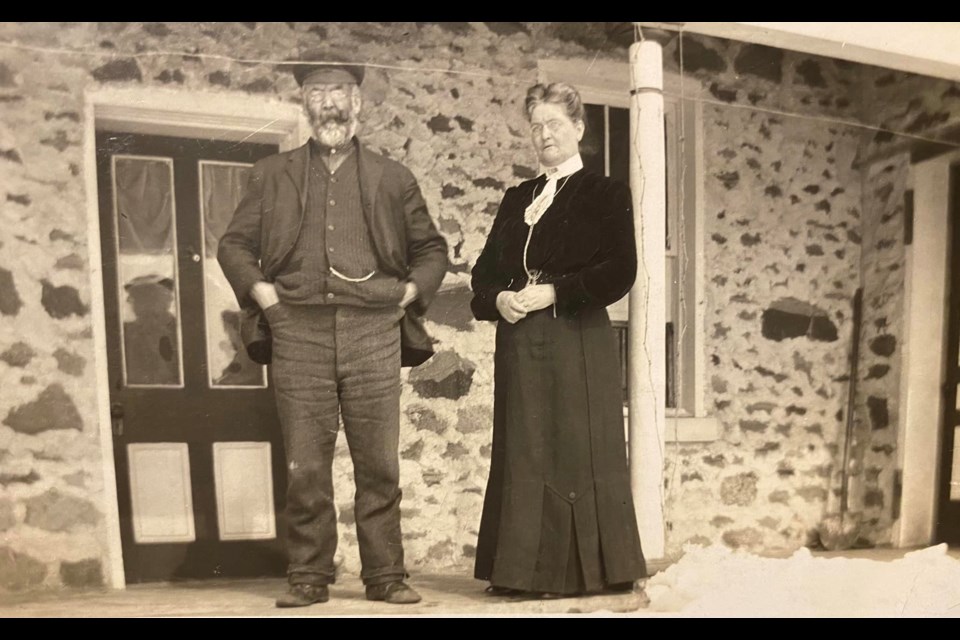This ongoing series from Barrie Historical Archive curator Deb Exel shows old photos from the collection and one from the present day, as well as the story behind them.
The Peter Spring House - 1878 Innisfil Beach Rd.
Stone houses seem to evoke certain impressions — unyielding, stability, craftsmanship, history. In particular, stone houses are enduring.
The story behind the modest stone house on the 8th line (1878 Innisfil Beach Road) starts around 1788, when Albright Spring came from Germany, settling in Rowan County, N.C.
Albright and his wife, Barbara, farmed in that area until 1796, when they sold their property.
The Springs and their seven children, along with an orphaned boy, left the U.S., making their way to Canada in a covered wagon. They put down stakes in Markham where the family remained.
Their children had children of their own. Albright’s son, Peter, would have a son, Isaac, in 1821. Isaac would grow up and marry a local Markham girl, Nancy Ferrier, in 1842.
In 1847, Isaac and Nancy moved to Innisfil Township, purchasing property on the 7th Concession.
Isaac, a United Empire Loyalist and hard-working farmer, would carry wheat on his back, travelling along an Indigenous trail from Innisfil to Holland Landing, to have it ground into flour. He later would own some of the first teams of oxen and horses in the area.
When the Ontario, Simcoe and Huron Railway line went thought his land, Spring laboured for weeks, moving barrows of earth to create the embankments. A powerful and vigorous man, the legend goes that Isaac Spring was said to have swam to Snake Island and back, a distance of six miles, on more than one occasion.
The Springs had strong spiritual convictions, and neither smoked nor drank. They were active in the Craigvale and 6th Line Presbyterian churches, where Isaac, a charter member of both, served as an elder and lay minister, when needed.
The Springs had eight children: Betsy, Nancy, Mary, Angeline, Annie, Peter, Isaac and Albert. Sadly, Angeline and Annie would die as infants.
Isaac and Nancy faced many hardships and challenges establishing a life in Innisfil. They lived in a humble log dwelling until a comfortable stone house was built in 1868.
As of the late 1960s, the lime kiln used to mix the mortar for their stone house still existed, and the stone home is often referred to as the Spring farm to this day.
The many descendants of Isaac and Nancy Spring would own several farms and properties in Innisfil Township.
Early settlers used materials at hand, like rocks from the field, in the construction of their buildings. As any pioneer farmer knew, the abundance of rocks encountered while clearing their land, could be put to use for rock fences and to build their houses, as log homes were typically replaced with stone or brick structures as soon as possible.
The Spring men worked together to construct the family homesteads, using these building materials harvested from the earth.
Isaac Sr.’s son, Peter, was born on the Spring farm in 1858. He married Margaret McConkey, daughter of Irish immigrant James McConkey and Scottish immigrant Janet Duncan, in 1880.
The young couple set up their household in a log cabin on lot 18 Concession 8, and after a period of time, built a frame house. They continued the tradition of a establishing a sturdy, robust dwelling for their family, by having mason (and thresher), George Alpin, stone the walls of their house in 1908.
In a gesture both creative and sentimental, Margaret provided fragments of dishes that belonged to her grandmother, brought from Scotland, to embed in the gable of their own stone home, the house we know today as 1878 Innisfil Beach Rd.
Peter and Margaret had five children: Isaac M., Edith, Zelma, Clarkson and Percy. Son Percy, born in the Innisfil Beach Road home in 1894, would serve in the 75th Infantry Battalion in the First World War, returning home a commissioned officer and placed on the Reserve of Officers.
After the war, Percy married Vera Tribble of Big Bay Point, settling in Toronto. Percy was recalled to service in the Second World War as an air force officer.
During the First World War, Peter and Margaret sold their farm at 1878 Innisfil Beach Rd., moving into Stroud. They purchased a summer place at the corner of the 8th Line and the 25th Sideroad, which remained in the Spring family for 90 years.
As a real estate agent, Peter sold many of the cottage lots in the Alcona and Cedar Harbour area.
Once home to several farming families, Peter Spring’s house now stands empty. This Ontario Gothic cottage with its rustic fieldstone exterior is a wonderful example of early rural workmanship.
The china remnants, still glittering in the gable of the old home, continue to honour the family’s ancestors and heritage, and are a distinctive and cherished part of the story, and history, of this quaint, enduring house.



